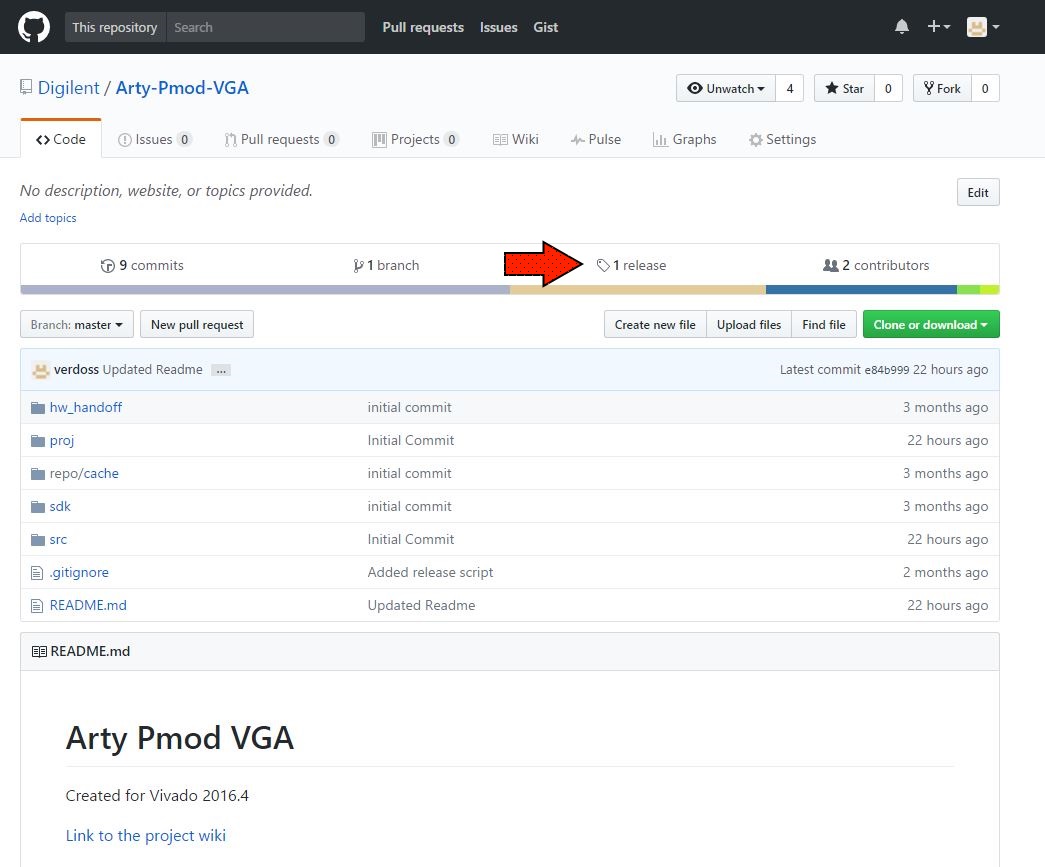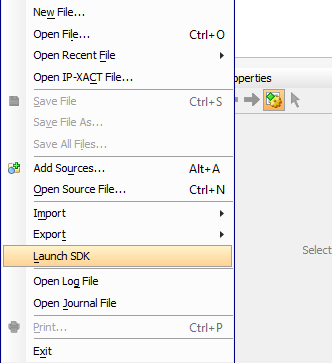Using Digilent Github Demo Projects
Overview
Digilent provides projects through Github that are designed to demonstrate different uses of our FPGA and Zynq boards. This guide will describe how to download and run these projects in Vivado 2016.
At the end of this tutorial you will have your demo project running on your board.
Prerequisites
Hardware
- A Digilent 7-Series FPGA or Zynq Board with a Supported Project
- USB Cables
Software
- Xilinx Vivado 2016.X
- Vivado 2016.4 is used in this tutorial
- Digilent Board Support Files
- Follow the wiki guide on how to install Board Support Files for Vivado 2016.X
- Projects Supported by this Tutorial
-
Important
For further requirements, such as a serial terminal, external power supply, or other hardware, please review the project's wiki page.
Tutorial
1. Download the Project ZIP from the Digilent Github
This step describes how to download a release from the Digilent Github, you can alternatively just download the project archive directly by clicking the link in the Projects Supported table above. The archive can be placed wherever you want, and will need to be extracted with Right click → Extract All.
- Download from Github
-
1.3) All of the necessary files are included within each project folder, with relative file paths established, so as long as the files aren't moved around within the folder, you can move and run the project from any location.
2. Open the Project
Select the “SDK Hardware Handoff” option if your project supports Vivado SDK and you want to jump directly in, otherwise select the “Vivado” option. Review the Supported Projects table above to determine if the project is an SDK project.
- SDK Hardware Handoff
-
2.2) Click Ok to finish launching SDK.
- Vivado
-
2.2) Open Vivado and find the Tcl Console on the bottom of the window. Enter the letters 'cd' (change directory) and paste the file path you copied earlier. Select the “proj” folder from the drop down menu to make sure that Vivado converts the path's back slashes ' \ ' to forward slashes ' / '.
Important
Vivado will not recognize paths that include back slashes, be very careful to make sure that it is properly converted.
2.3) Enter the command “source ./create_project.tcl”, this will set up the project for you within the proj directory you previously cd'd into.
3. Generate Bitstream
Skip this step if you previously selected the “SDK Hardware Handoff” option.
- Generate Bitstream
-
3.1) Click Generate Bitstream on the left hand menu towards the bottom. In the “Launch Runs” dialog, make sure Launch runs on local host is selected and click OK. In the “No Implementation Results Available” dialog, click Yes to run synthesis and implementation.
Tip
If your computer has multiple CPU cores, you can increase the number of jobs to make this process faster.
3.2) When this process has finished, which may take a while, in the “Bitstream Generation Completed” dialog you will be presented with several options. You can Open Implemented Design to view how your design will be placed onto the FPGA. View Reports will show you a number of different diagnostics on your project, including how the resources of your board will be used. Open Hardware Manager is used to program the bitstream onto the board (this will not be used for the SDK flow). Generate Memory Configuration File creates a file that can be used to program the bitstream from local memory on your device.

4. Import SDK Projects
Skip this step if your project doesn't support SDK.
- SDK Hardware Handoff
-
4.5) Back in “Import Projects”, make sure that the hw_handoff, application, and application board support package (BSP) projects are all checked, then click Finish to open the projects in SDK.
- Launch from Vivado
-
4.1) If the “Generate Bitstream Complete” dialog is still open, click Cancel.
5. Run the Project
If you have opened your project in SDK in previous steps, select the “SDK” option, otherwise, select “Vivado”.
- SDK
-
5.1) Ensure your board is turned on and connected to your computer with a USB cable.5.2) Revisit the project's wiki page to check for extra requirements, such as setting up a serial terminal, or connecting additional cables.5.5) The project will now be programmed and running on your board and you can return to the project's wiki page to verify functionality.
- Vivado
-
5.1) Ensure your board is turned on and connected to your computer with a USB cable.5.2) Revisit the project's wiki page to check for extra requirements, such as setting up a serial terminal, or connecting additional cables.5.7) Select Program Device from the green bar, then select your device from the dropdown list (there will usually only be one device listed). Then click Program.
Important
If nothing shows up in the “Bitstream file” text box, click the … button to the right, navigate to “proj/*.runs/impl_1” subdirectory of your project and select the “*.bit” file.
5.8) The project will now be programmed and running on your board and you can return to the project's wiki page to verify functionality.
























